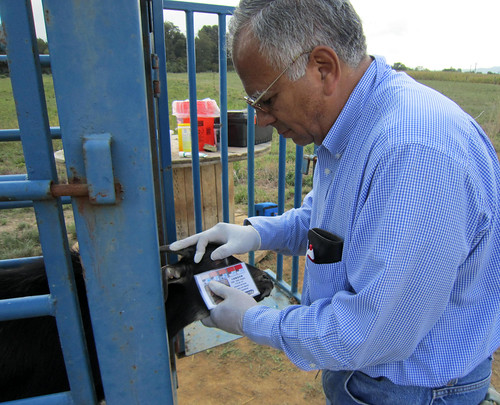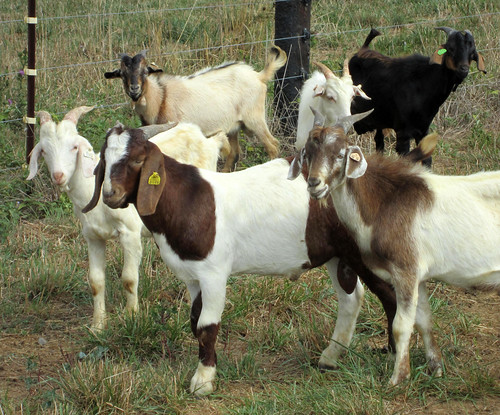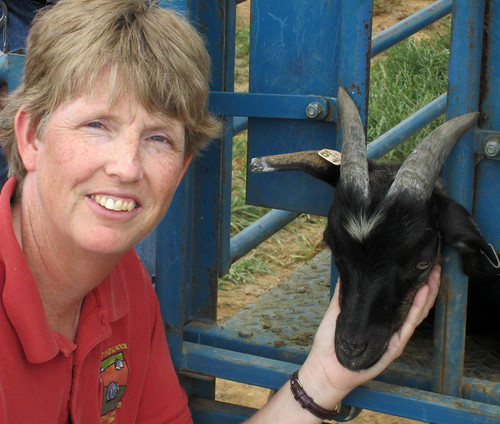Nelson Escobar determined FAMACHA©, body condition, coat condition, and dag scores. David Gordon weighed the goats. Susan Schoenian could not handle the goats due to a back injury.
 |
| Nelson Escobar determines a FAMACHA© score |
Poor pasture = weight loss
Poor pasture conditions were the obvious cause of an average weight loss of 1.63 lbs. or -0.126 lbs. per day over the previous 13 days. For the 68 goats on test, weight loss/gain ranged from -5 to + 4 lbs.
The only goat to gain 4 lbs. (0.308 lbs. per day) was a Kiko buck (#1) consigned by Craig Adams. The performance of the #1 goat is noteworthy because he nearly died (of Haemonchosis) during the adjustment period in June.
This current weight loss, combined with no gain the previous two weeks, has reduced the overall gain of the goats in the test to 0.082 lbs. per day. For the first 70 days of the test, average daily gain (ADG) has ranged from -0.058 to 0.275 lbs. per day. Craig Adams' #2 Kiko goat is still the top-gaining buck in the test.
FAMACHA© scores ranged from 1 to 4 and averaged 2.1, compared to 1.8 two weeks ago (and 1.5 four weeks ago). Only two goats required anthelmintic treatment. They were dewormed with levamisole (Prohibit drench, 3 ml/50 lbs.). Unless there are other reasons, only goats with FAMACHA© scores of 4 or 5 are dewormed.
 |
| Some of the bucks |
Decline in body condition
Body condition scores ranged from 1.5 to 3.0 and averaged 2.2, compared to 2.3 two weeks ago (and 2.5 four weeks ago). Body condition scores of 3 are considered to be "good."
A body condition score of 2 equates to "thin." Thus, body condition scores below 2 are thinner than is preferred for the health and thriftiness of the goat. Ten goats had body condition scores below 2. Coat condition scores remained unchanged. Only two goats had dag scores above 1.
Some of the differences in FAMACHA©, body condition, coat condition, and dag scores may be attributed to scorer "bias," as scores have been determined by three different people over the past six weeks. FAMACHA©, body condition, coat condition, and dag scores are all subjective scores. Only weight is an objective measurement.
Low egg counts
For the fecal samples collected on August 12, egg counts ranged from 0 to 2,750 eggs per gram and averaged just 259 epg. Only four goats had egg counts above 1,000 epg. Only one goat had a fecal egg count above 2,000 epg, the pathogenic burden for the barber pole worm.
 |
| Susan with the #1 (ID) goat |
Test conditions
While the test site received some rainfall over the past two weeks, pasture conditions remain poor. Some regrowth can be observed. The two acre paddock of dwarf pearl millet has been closed off, to allow it to regrow.
Other fields are being closed off (temporarily) to encourage the goats to eat the round bale of hay. Despite the sparse pasture conditions (and weight loss), the goats have continued to avoid the hay and protein tubs. They "insist" on foraging for their feed.
Hopefully, the test site will get enough forage production to allow the goats to achieve some compensatory gains during the last 28 days of the test. On the other hand, this year's drought and extreme heat have served as "stressors" to evaluate the toughness or hardiness of the goats on test.
Goats tend to fare better in a drought than other livestock. Any goat can thrive when the feed supply is plentiful. Not all goats can handle the stressful conditions that this year's test has imposed.
Download August 25 (d-70) report











